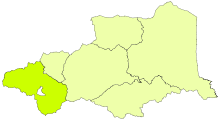French Cerdagne
Coordinates: 42°30′N 1°58′E / 42.500°N 1.967°E


French Cerdagne (Catalan: Alta Cerdanya, IPA: [ˈaɫtə sərˈðaɲə]) is the northern half of Cerdanya, which came under French control as a result of the Treaty of the Pyrenees in 1659, while the southern half remained in Spain (as part of Catalonia). Catalans often refer to French Cerdagne as Upper Cerdanya (Catalan: Alta Cerdanya). It is the only French territory in the Iberian Peninsula, as it is on the south side of the Pyrenees range between Spain and France.[1][2][3] For example, the Segre river, which goes west and then south to meet the Ebro, has its source in the French Cerdagne. An inadvertent result of the Treaty of the Pyrenees is the Spanish exclave of Llivia (the small uncolored area in the map) which is sovereign Spanish territory completely surrounded by French Cerdagne.
French Cerdagne has no special status inside France, simply forming an area within the department of Pyrénées-Orientales, unlike the Spanish part of Cerdanya, which is officially a Catalan comarca called simply Cerdanya. In France, the French area is referred to as either Cerdagne française (i.e. "French Cerdagne"), Haute Cerdagne (i.e. "Upper Cerdagne") or just Cerdagne.
French Cerdagne has a land area of 539.67 km² (208.37 sq. miles). Its 1999 population was 12,035, resulting in a density of only 22 people per km² (58 per sq. mile).
French Cerdagne has the most cloud-free days in France, and was therefore chosen as the place to build:
- the solar furnace of Odeillo (Catalan: Odelló) (official site), used for high-temperature scientific experiments;
- the Thémis experimental solar power plant (operated by EDF from 1983 to 1986); it is now decommissioned as a power plant, but is being used as a Cerenkov telescope for the detection of Gamma rays
Communes
Population at the 1999 French census.
- Angoustrine-Villeneuve-des-Escaldes (Catalan: Angostrina) - pop. 549
- Bolquère (Catalan: Bolquera) - pop. 730 (779 at 2004 census)
- Bourg-Madame (Catalan: La Guingueta d’Ix) - pop. 1,166 (1,198 at 2004 census)
- Dorres - pop. 219
- Égat (Catalan Èguet) - pop. 494 (475 at 2004 census)
- Enveitg (Catalan Enveig) - pop. 621
- Err (Catalan Er) - pop. 551
- Estavar - pop. 409
- Eyne (Catalan Eina) - pop. 127 (161 at 2004 census)
- Font-Romeu-Odeillo-Via (Catalan Font-Romeu, Odelló i Vià) - pop. 2,003
- La Cabanasse (Catalan La Cabanassa) - pop. 622 (756 at 2004 census)
- Latour-de-Carol (Catalan La Tor de Querol) - pop. 367
- Llo - pop. 133
- Mont-Louis (Catalan Montlluís) - pop. 270
- Nahuja (Catalan Naüja) - pop. 63
- Osséja (Catalan Osseja) - pop. 1,282
- Palau-de-Cerdagne (Catalan Palau de Cerdanya) - pop. 424 (496 at 2004 census)
- Planès - pop. 27
- Porta - pop. 98
- Porté-Puymorens (Catalan Portè) - pop. 147
- Saillagouse (Catalan Sallagosa) - pop. 820
- Saint-Pierre-dels-Forcats (Catalan Sant Pere dels Forcats) - pop. 213
- Sainte-Léocadie (Catalan Santa Llocaia) - pop. 140
- Targassonne (Catalan Targasona) - pop. 203 (194 at 2004 census)
- Ur - pop. 308
- Valcebollère (Catalan: Vallsabollera) - pop. 49
References
- ↑ Peter Sahlins (1989). Boundaries: The Making of France and Spain in the Pyrenees. University of California Press. p. 49. ISBN 978-0-520-91121-5.
- ↑ Paul Wilstach (1931). Along the Pyrenees. Robert M. McBride Company. p. 102.
- ↑ James Erskine Murray (1837). A Summer in the Pyrenees. J. Macrone. p. 92.
See also
Literature
- Peter Sahlins, Boundaries. The Making of France and Spain in the Pyrenees (Berkeley: Univ. of California Press, 1989). ISBN 0-520-07415-7
External links
- L'Alta Cerdanya in Catalan Encyclopaedia.
- Tourism in Cerdagne